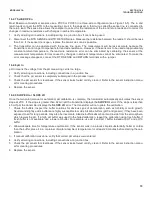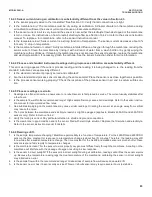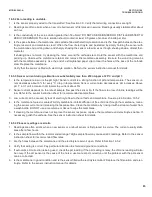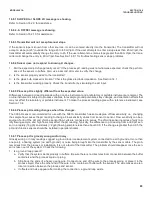
88
MODEL 5081-A
SECTION 16.0
TROUBLESHOOTING
16.7.4 Process readings are erratic.
1. Readings are often erratic when a new sensor or a rebuilt sensor is first placed in service. The current usually stabi-
lizes after a few hours.
2. Is the sample flow within the recommended range? High sample flow may cause erratic readings. Refer to the sensor
instruction sheet for recommended flow rates.
3. Are the holes between the membrane and the electrolyte reservoir open. Refer to Section 16.7.2.
4. Verify that wiring is correct. Pay particular attention to shield and ground connections.
5. Is the membrane in good condition and is the sensor filled with electrolyte solution? Replace the fill solution and elec-
trolyte. Refer to the sensor instruction manual for details.
16.7.5 Readings drift.
1. Is the sample temperature changing? Membrane permeability is a function of temperature. The time constant for the
499AOZ sensor is about five minutes. Therefore, the reading may drift for a while after a sudden temperature change.
2. Is the membrane clean? For the sensor to work properly, ozone must diffuse freely through the membrane. A coating
on the membrane will interfere with the passage of ozone, resulting in slow response. Clean the membrane by rinsing
it with a stream of water from a wash bottle, or gently wipe the membrane with a soft tissue.
3. Is the sample flow within the recommended range? Gradual loss of sample flow will cause a downward drift.
4. Is the sensor new or has it been recently serviced. New or rebuilt sensors may require several hours to stabilize.
16.7.6 Sensor does not respond to changes in ozone level.
1. Is the grab sample test accurate? Is the grab sample representative of the sample flowing to the sensor?
2. Is the membrane clean? Clean the membrane and replace it if necessary. Check that the holes at the base of the cath-
ode stem are open. Use a straightened paper clip to clear blockages. Replace the electrolyte solution.
3. Replace the sensor.
16.7.7 Ozone readings are too low.
1. Was the sample tested as soon as it was taken? Ozone solutions are highly unstable. Test the sample immediately
after collecting it.
2. Low readings can be caused by zeroing the sensor before the residual current has reached a stable minimum value.
Residual current is the current the sensor generates even when no ozone is in the sample. Because the residual cur-
rent is subtracted from subsequent measured currents, zeroing before the current is a minimum can lead to low results.
See Section 16.4.8 for more information.
3. Sensor response depends on flow. If the flow is too low, readings will be low and flow sensitive. Verify that the flow
past the sensor equals or exceeds the minimum value. See the sensor instruction manual for recommended flows.
16.8 pH MEASUREMENT AND CALIBRATION PROBLEMS
Problem
See Section
SLOPE HI or SLOPE LO message is showing
16.8.1
-0- OFFSEt message is showing
16.8.2
Transmitter will not accept manual slope
16.8.3
Sensor does not respond to known pH changes
16.8.4
Process pH is slightly different from the expected value
16.8.5
Process pH reading changes when flow changes
16.8.6
Process pH is grossly wrong and/or noisy
16.8.7
Process readings are noisy
16.8.8
Summary of Contents for Rosemount Analytical HART 5081-A-HT
Page 22: ...FIGURE 4 2 FM Intrinsically Safe Installation Label 16 ...
Page 25: ...FIGURE 4 4 CSA Intrinsically Safe Installation Label 19 ...
Page 26: ...FIGURE 4 5 CSA Intrinsically Safe Installation 1 of 2 20 ...
Page 27: ...FIGURE 4 5 CSA Intrinsically Safe Installation 2 of 2 21 ...
Page 108: ...FIGURE 4 Wiring to Model 5081 102 MODEL 4000 WIRING ...
Page 110: ...104 ...
















































